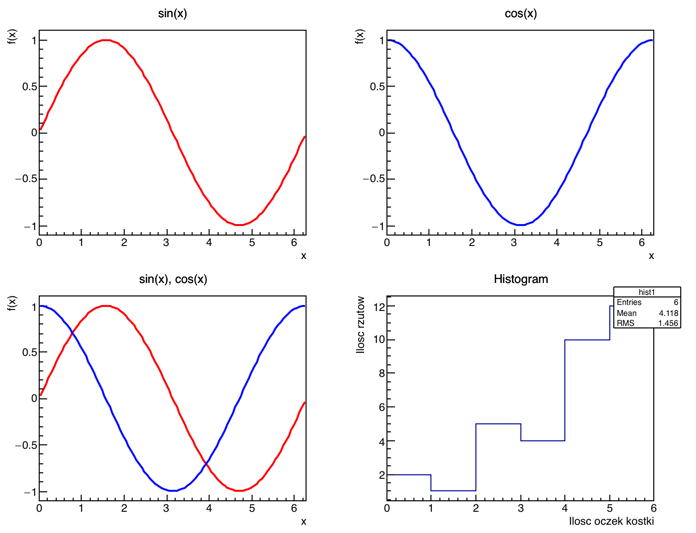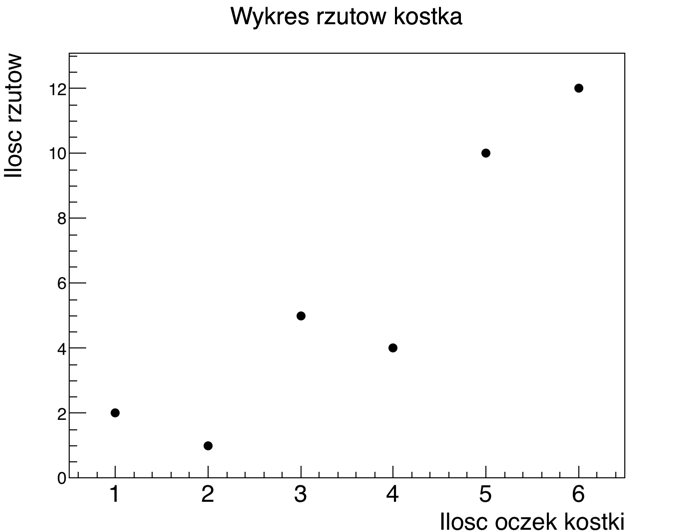|
|
| (2 intermediate revisions not shown) |
| Line 10: |
Line 10: |
| | * documentation of the laboratory version (5.32.00): [https://root.cern.ch/root/html532/ https://root.cern.ch/root/html532/] last version with the old C++ interpreter | | * documentation of the laboratory version (5.32.00): [https://root.cern.ch/root/html532/ https://root.cern.ch/root/html532/] last version with the old C++ interpreter |
| | | | |
| - | == Zadanie == | + | == Exercise == |
| - | 1. Należy napisać makro, które: | + | 1. Write a macro, which: |
| - | * tworzy obiekt <code>fun1</code> typu <code>TF1</code> reprezentujący funkcję <code>sin(x)</code> (patrz klasa <code>TMath</code>) | + | * creates an object <code>fun1</code> of type <code>TF1</code> representing a <code>sin(x)</code> function (see class <code>TMath</code>) |
| - | * tworzy obiekt <code>fun2</code> typu <code>TF1</code> reprezentujący funkcję <code>cos(x)</code> | + | * creates an object <code>fun2</code> of type <code>TF1</code> representing a <code>cos(x)</code> function |
| - | * tworzy okno z 4 panelami (rozkład paneli 2x2) - patrz klasa <code>TCanvas</code> i metoda <code>Divide</code> | + | * creates a window with 4 panels (panel distribution 2x2) - see class <code>TCanvas</code> and method <code>Divide</code> |
| - | * rysuje obiekt <code>fun1</code> na 1 panelu, <code>fun2</code> na 2 panelu, oraz obie funkcje jednocześnie na 3 panelu | + | * draws the <code>fun1</code> object on panel 1, <code>fun2</code> on panel 2, and two functions simultaneously on panel 3 |
| - | * zmieni kolor linii funkcji <code>fun2</code> na niebieski - patrz metoda <code>SetLineColor</code> i klasa <code>TColor</code> | + | * changes the color of the line of function <code>fun2</code> to blue - see method <code>SetLineColor</code> and class <code>TColor</code> |
| | <br> | | <br> |
| - | 2. Wyobraźmy sobie, że rzucamy niesymetryczną sześcienną kostką do gry. Wyniki podsumowuje poniższa tabelka: | + | 2. Let's imagine we throw a dice that is asymmetric. The table below summarizes the results: |
| | {| class="wikitable" border="1" | | {| class="wikitable" border="1" |
| | |- | | |- |
| - | ! Ilość oczek | + | ! Number of pips |
| | | 1 | | | 1 |
| | | 2 | | | 2 |
| Line 29: |
Line 29: |
| | | 6 | | | 6 |
| | |- | | |- |
| - | ! Ilość rzutów | + | ! Number of throws |
| | | 2 | | | 2 |
| | | 1 | | | 1 |
| Line 37: |
Line 37: |
| | | 12 | | | 12 |
| | |} | | |} |
| - | Modyfikujemy dalej makro:
| + | We modify further the macro: |
| - | * tworzymy histogram (patrz klasa <code>TH1D</code>) wypełniając kolejne biny (odpowiadające kolejnym ilościom oczek) wartościami z tabelki (ilość rzutów) - histogram należy narysować na panelu 4 | + | * let's create a histogram (see class <code>TH1D</code>) by filling each bin (which corresponds to each dice facet) with values from the table (number of throws) - the histogram should be plotted on panel 4 |
| - | * należy stworzyć wykres - graf (patrz klasa <code>TGraph</code>) zgodnie z wartościami z tabelki. | + | * create a plot, called graph (see class <code>TGraph</code>) according to values from the table. |
| - | * zmienić styl punktów grafu na kółko (patrz metoda <code>SetMarkerStyle</code> oraz klasa <code>TAttMarker</code>) | + | * change the style of graph points (see method <code>SetMarkerStyle</code> and class <code>TAttMarker</code>) |
| - | * narysować graf w oddzielnym oknie | + | * draw the graph in a separate window |
| | | | |
| - | == Uwagi == | + | == Attention == |
| - | * <b>Uwaga!</b> Aby środowisko ROOT można było uruchomić na własnym koncie użytkownika w laboratorium, należy w pliku <code>$HOME/.bashrc</code> dopisać następujące linijki (jeśli nie były dodane na zajęciach z PTI): | + | * <b>Attention!</b> In order to run ROOT environment on your student account in the laboratory, you have to add the following lines (if they were not added already) to the file <code>$HOME/.bashrc</code> (they could had been added during the PTI class): |
| | export ROOTSYS=/opt/root | | export ROOTSYS=/opt/root |
| | export PATH=$PATH:$ROOTSYS/bin | | export PATH=$PATH:$ROOTSYS/bin |
| | export LD_LIBRARY_PATH=$LD_LIBRARY_PATH:$ROOTSYS/lib | | export LD_LIBRARY_PATH=$LD_LIBRARY_PATH:$ROOTSYS/lib |
| - | * środowisko ROOT jest zainstalowane lokalnie na każdym komputerze - nie jest dostępne na serwerze | + | * the ROOT environment is installed separately on each computer - it is not available on the server |
| - | * w środowisku ROOT piszemy <b>makra</b>, które mają rozszerzenie .c, .C, .cpp, lub .cxx | + | * in the ROOT environment we write <b>macros</b>, which have extensions .c, .C, .cpp, or .cxx |
| - | * makro zawiera w sobie kod w języku C++ interpretowany linijka po linijce | + | * a macro contains a C++ code interpreted line-by-line |
| - | * w zasadzie nie musimy załączać żadnych bibliotek | + | * in principle, we do not need to include any libraries |
| - | * przykład 1: | + | * example 1: |
| | { | | { |
| | double x = 5; | | double x = 5; |
| | cout<<x<<endl; | | cout<<x<<endl; |
| | } | | } |
| - | * wywołanie makra: uruchamiamy środowisko (komenda <code>root</code>), wpisujemy <code>.x macro.C</code> | + | * execution of a macro: start the environment (command <code>root</code>), type <code>.x macro.C</code> |
| - | * makro może zawierać również <b>funkcje</b>, przykład 2: | + | * macro can also contain <b>funkcje</b>, example 2: |
| | int macro() | | int macro() |
| | { | | { |
| Line 65: |
Line 65: |
| | return 1; | | return 1; |
| | } | | } |
| - | * nazwa makra musi być taka sama jak nazwa funkcji w makrze (by można było je uruchomić komendą <code>.x macro.C</code>) | + | * name of the macro must be the same as the name of the main function in the macro (in order to run it with the command <code>.x macro.C</code>) |
| - | * w makrach może być więcej funkcji - przy standardowym uruchomieniu wywołana zawsze będzie ta funkcja, której nazwa zgadza się z nazwą makra (odpowiednik funkcji <code>main</code> w standardowym C++) | + | * macros can contain more functions - during the macro execution the one which will be run is that which name corresponds to the macro name (the equivalent of the <code>main</code> function in standard C++) |
| | | | |
| - | == Wynik == | + | == Results == |
| - | Wykresy:
| + | Plots: |
| - | * okno 1 | + | * window 1 |
| | [[File:lab1_1.png]] | | [[File:lab1_1.png]] |
| - | * okno 2 | + | * window 2 |
| | [[File:1_2.png]] | | [[File:1_2.png]] |
1. Write a macro, which:

